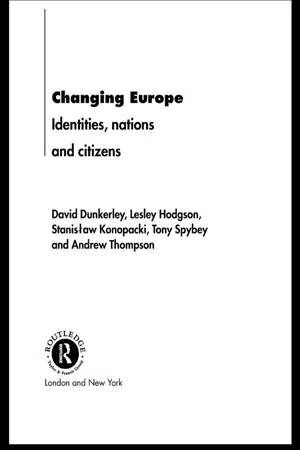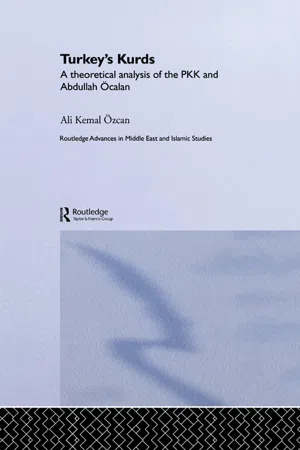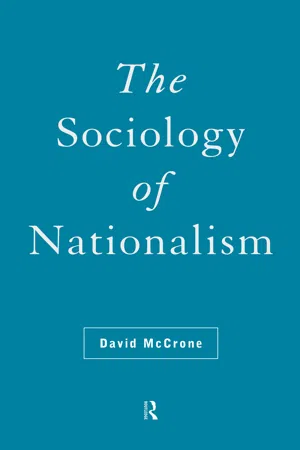History
Post War Nationalism
Post-war nationalism refers to the surge of patriotic sentiment and pride in one's nation following a major conflict, such as World War I or World War II. It often involves a desire for independence, self-determination, and the preservation of national identity. Post-war nationalism can lead to the formation of new nations, changes in government, and shifts in international relations.
Written by Perlego with AI-assistance
Related key terms
6 Key excerpts on "Post War Nationalism"
- eBook - ePub
Reassessing Political Ideologies
The Durability of Dissent
- Michael Freeden(Author)
- 2004(Publication Date)
- Routledge(Publisher)
The same point would hold for many anti- and postcolonial nationalisms of the twentieth century. The national renewal of postcolonial regimes in Africa or Asia during the twentieth century was, in part, also a recovery of national myths promulgated, or, in some cases, foisted onto earlier history. The language of national recovery, in postcolonial terms, was itself also partly adopted from the European political vocabularies of the colonial and imperial era. There is a sense in which nationalism always contains its own self-fulfilling historical prophecy, wherever it occurs. In effect, it commandeers history and tradition to establish its own existence and ineffable continuity with the past. All history therefore becomes literally the history of the nation.During the twentieth century there have been two broad approaches to nationalism both within political and historical studies to date, as well as in the apprehensions of ordinary citizens of most states. One approach has been generally uneasy with nationalism. This sense of unease was profoundly affected in most European states (and in some Asian states like Japan) – on theoretical and practical levels – by the events surrounding the Second World War. Thus, for many, national socialism, fascism and extreme authoritarianism marked out early to mid-twentieth-century nationalism for specific abhorrence. Many commentators, from the 1930s period up to 1989, consequently saw nationalism as an unduly narrow, tribalist, potentially totalitarian, and inherently irrationalist and bellicose doctrine. Furthermore, liberal, Marxist and social democratic theories in this same period (particularly post-1945), self-consciously developed more internationalist or cosmopolitan stances. This was the era of the setting up of the significantly titled United Nations. The only exceptions to this anti-nationalist process, for some, were the various anti-colonial nationalisms, which had an emancipatory imprimatur. - eBook - ePub
Nationalism in Europe and America
Politics, Cultures, and Identities since 1775
- Lloyd S. Kramer(Author)
- 2011(Publication Date)
- The University of North Carolina Press(Publisher)
This chapter therefore brings the history of modern nationalism toward the present era by noting briefly how post-1945 nationalisms replicated nineteenth-century nationalist movements and also began to transform older nationalist themes in a postcolonial world. The breakup of European empires in Asia and Africa helped to change both the populations and the traditional nationalist assumptions within European societies. Indeed, the collapse of global empires coincided with an emerging transnational movement for cooperation among the previously warring European nation-states and a new recognition of the diversity within national cultures. Older ideas about multicultural empires gradually gave way to new ideas about multicultural nations and a unified, multicultural Europe. The history of nationalism since the Second World War thus includes the continuing development of anticolonialism as well as the concurrent emergence of a new transnational collaboration or “internationalism” among the political elites of long-established European states. It is also true, however, that nationalism continued to pervade political and cultural life, so that nationalist ideas and emotions reappeared regularly in political responses to the collapse of communist states, to terrorism, to immigration, and to economic globalization. This overview of nationalism’s post-1945 influence and evolution thus comes back finally to nationalist themes that remain important in the twenty-first-century political cultures of nations such as the United States and France.Decolonization and the Global Struggles for National Independence
Woodrow Wilson’s emphasis on national “self-determination” attracted much global attention at the end of the First World War, but, as noted in the previous chapter, nationalists such as Ho Chi Minh quickly recognized that this concept would not be applied to the European colonies in Asia or Africa. France and Great Britain actually expanded their imperial influence by dissolving Germany’s overseas empire and receiving League of Nations “mandates” to govern most of the former Ottoman Empire in the Middle East. Ho Chi Minh’s complaints about the European denial of national rights were therefore repeated far beyond Versailles and wherever intellectual elites had launched campaigns against Western imperialism. The Chinese nationalist Sun Yat-sen (1866–1925), for example, summarized this perspective in a typical nationalist argument in the “post-Wilsonian” context of the early 1920s. Although Sun stressed that the “great phrase, used by President Wilson and warmly received everywhere—‘self-determination of peoples’”—seemed to promise a new era of national autonomy, he complained bitterly that Asians and Africans soon faced what he called “an oppression more terrible than before.” To be sure, the idea of “self-determination” did not disappear, and yet the Western powers simply decided to ignore it in other regions of the world. New anti-imperial movements therefore “began independently and separately to carry out the principle of the ‘self-determination of peoples,’” thereby taking action to resist Europe’s global hegemony and to affirm the importance of autonomous national cultures. Sun described this evolving national consciousness in his own Chinese society as a pervasive determination “to revive China’s lost nationalism and use the strength of our four hundred million to fight for mankind against injustice; this is our divine mission.”2 - eBook - ePub
Ethnic Nationalism And Regional Conflict
The Former Soviet Union And Yugoslavia
- W. Raymond Duncan(Author)
- 2019(Publication Date)
- Routledge(Publisher)
Introduction: Ethnic Nationalism in the Post-Cold War EraW. Raymond Duncan and G. Paul Holman , Jr .Nationalism is not necessarily a negative phenomenon in contemporary world affairs. By forging identity with "a people" as the central focus of loyalty, nationalism can serve as a basis for collective solidarity to legitimize governing institutions and stimulate economic growth.1 In nineteenth-century England, France, and America, as one observer notes, national identity and nationalism offered "roads to modernity."2 Indeed, post-World War Two West Germany and Japan illustrate how patriotic devotion to one's country unifies and mobilizes individuals for remarkable economic and political development. In short, nationalism is inherently neither good nor bad, but a fact of life that shows a capacity for both good and evil.Still, when one nation glorifies itself at the expense of others—as in national chauvinism, jingoism, xenophobia, fascism and other doctrines—it becomes a negative force in world politics. Nationalism in Germany and Japan during the inter-war period and World War Two, with its xenophobic feelings of superiority vis-à-vis other national groups, illustrates the point. Although not an evil in and of itself, then, nationalism has the potential to stir up trouble.Our aim in this book is not to indict nationalism, cultural pluralism, or pride in one's heritage. Certainly the self-esteem gained from one's cultural and national roots has its place in modern society, for as Arthur M. Schlesinger, Jr., reminds us, "nationalism remains, after two centuries, the most vital political emotion in the world—far more vital than social ideologies such as communism or fascism or even democracy."3 Our focus is rather on one form of nationalism that has become increasingly pronounced in recent years: ethnic nationalism, - eBook - ePub
Changing Europe
Identities, Nations and Citizens
- David Dunkerley, Lesley Hodgson, Stanislaw Konopacki, Tony Spybey, Andrew Thompson(Authors)
- 2003(Publication Date)
- Routledge(Publisher)
So far we have said little about why nationalism emerges in Europe and what factors contribute to its development. Both of these issues are nevertheless central to our understanding of nationalism. As we will show, there are two ways of exploring these issues. The first deals with the long-term rise of nationalism, and focuses on the forces that led to its early development in the eighteenth century and its subsequent transformation. We are therefore interested in the impact of concomitant social changes, such as the rise of industrialisation, the development of the modern state, or other such significant social transformations. In contrast the second approach is what Brubaker (1996) terms an ‘eventful’ analysis of nationalism, in which the accent is on nationalism activated in particular conditions.Before we turn to these issues, let us make two opening points about the rise and transformation of nationalism in Europe. First, nationalisms and national identities have been constant features of European societies since the second half of the nineteenth century. This is not to say that the form and content of nationalisms in European societies have remained the same, for they have not. Equally, it is important that we do not view nationalism as something that disappeared off the radar after the end of the Second World War only to reappear at the close of the twentieth century, when it played such a pivotal role in the fragmentation of the former Yugoslavia, Czechoslovakia and the Soviet Union. Too often commentators, whose myopia may be partly attributed to wishful thinking, have been surprised by ‘resurgences’ of nationalism. Cobban (1969) observes that opinion among British and American writers during the Second World War was that the principle of nationhood should not be allowed to form the basis of a post-war political order. As he remarks in memorable terms, for these writers nationalism was a ‘survival of a dead age, the ghosts of Garibaldi, Mazzini, Byron, Bolívar, come back . . . to haunt an age in which all they stood for no longer has any right to exist’ (1969: 13). Later, Smith (1979), responding to the growth in support for nationalist movements and political parties in regions in which modernisation was supposed to have eroded the appeal of separatist nationalisms, such as Brittany, Catalonia, Flanders, Scotland and Wales, comments that ‘the so-called “demise of nationalism” in mid-century Europe has been more apparent than real’ (1979: 152). Moreover, we can lose sight of the significance of nationalism across Europe if we view it as something that happens only in seemingly pathological situations, such as Northern Ireland, the Basque Country, Bosnia, Kosovo and Moldova, or in contexts where emotions have been stretched to breaking-point, as in the rivalries between Croatia and Serbia, or, sometimes, between western governments such as between those of France and the UK. If we follow Billig's (1995) advice, then, by broadening our definition of nationalism to include all the habits and practices by which the nation is reproduced, it becomes apparent just how embedded nationalism is in all European societies. So, then, we should not be surprised at the recent high profile of nationalism across Europe. - eBook - ePub
- Ali Kemal Özcan(Author)
- 2012(Publication Date)
- Routledge(Publisher)
keeping things in one’s own hands. And this politics took shape in accordance with the needs and results of modernity’s industrialization – in fact, its severe ‘uneven diffusion’ (Gellner 1964: 166). An additional catalyst for over-pushing the implantation of nationalism’s power of perversion into the ‘national consciousness’ of the lower social strata is that it has been well grasped as a reaction or counterattack by everyone from the young bourgeoisie in its heyday to infantile Marxism: a political and ideological antidote.The perverted ethnic-primordial sentiments among Nietzsche’s ‘herd’ has duly produced a European saying that deserves repetition: ‘A nation is a group of persons united by a common error about their ancestry and a common dislike of their neighbours.’ The fortunate thing appears to be that the bourgeoisie of global capitalism in our time is, as a matter of fact, not adolescent any more. And accordingly, the flooding ‘localization of globalization’ (Deutsch 1969: 169–174) – in keeping with supranational market ‘sentiments’ – has been pushing nationalism of any ‘type’ towards obsolescence. This has also been the fate of the communists’ nationalism of ‘laborious sentiments’.The Twilight of ‘Communist Nationalism’No argument can be conducted by the scholars of nation and nationalism without taking on board what Marxism has said and done. Although both Marx and Marxism – with all its variants – have so far had no significant effect upon the factual course of the part of history called ‘the era of nationalism’, this is conspicuously the case. And this is why Anderson rightly states that ‘nationalism has proved an uncomfortable anomaly for Marxist theory and, precisely for this reason, has been largely elided rather than confronted’ (Anderson 1983: 13). By this I take him to mean that the adolescent bourgeoisie’s rational nationalism has triumphed over infantile Marxism’s emotional - eBook - ePub
The Sociology of Nationalism
Tomorrow's Ancestors
- David McCrone(Author)
- 2002(Publication Date)
- Routledge(Publisher)
contra Fukuyama, history was only beginning. Territories were rediscovering their histories and connecting them into their futures, often determined to go their separate ways. The monochrome of the Cold War gave way to the kaleidoscope of cultures rediscovered and reinvented.Many did not like what they saw. Eric Hobsbawm, who was suspicious of nationalism in East and West, voiced admiration and regret for the passing of the old order: ‘It was’, he commented, in melancholic retrospect, ‘the great achievement of the communist regimes in multinational countries to limit the disastrous effects of nationalism within them’ (Hobsbawm, 1990:173). The Russian and Yugoslav revolutions had, he judged, at least prevented the nationalities killing each other. There was method in the madness of the old communist regimes which allowed the nationalities merely to dance. Hobsbawm predicted that the end of communism was likely to lead to greater oppression against and discrimination of minorities in new democratic states, and he pointed out that anti-Semitism in the Baltic states and Ukraine was at least the equal of Nazi Germany.Much of this analysis sought to juxtapose nationalism and internationalism, and this brought former communists like Hobsbawm to question the liberal tenet laid down by Woodrow Wilson after the Great War: ‘In the early 1990s, perhaps for the first time, rational observers irrespective of politics (other than those of some specific group of nationalist activism) began publicly to propose the abandonment of the “right of self-determination” ’ (Hobsbawm, 1994:567). It might seem odd to propose the abandonment of a principle never actually operational in much of Europe, but it indicated a key perspective on the fall of communism: the rise of nationalism. Terms like ‘balkanisation’ re-emerged with added vigour as the phenomenon took shape before our eyes, and a new conventional wisdom emerged, shared by Right and Left alike: the theory of the ethnic abyss.
Learn about this page
Index pages curate the most relevant extracts from our library of academic textbooks. They’ve been created using an in-house natural language model (NLM), each adding context and meaning to key research topics.





